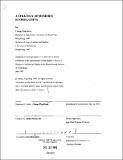| dc.contributor.advisor | Attilio Petruccioli. | en_US |
| dc.contributor.author | Chang, Ping Hung | en_US |
| dc.coverage.spatial | a-cc--- | en_US |
| dc.date.accessioned | 2011-08-01T14:32:10Z | |
| dc.date.available | 2011-08-01T14:32:10Z | |
| dc.date.copyright | 1995 | en_US |
| dc.date.issued | 1995 | en_US |
| dc.identifier.uri | http://hdl.handle.net/1721.1/65043 | |
| dc.description | Thesis (M.S.)--Massachusetts Institute of Technology, Dept. of Architecture, 1995. | en_US |
| dc.description | Includes bibliographical references (leaves 163-166). | en_US |
| dc.description.abstract | The thesis is trying to establish a strategy of memory for the urban preservation of old cities, like Suzhou, within the context of the rapid growing economy in Southern China. The general attitude towards the problem starts from a critical viewpoint which acquires a sharp, yet fair, evaluation of the existing preservation policy of Suzhou with respect to time, place and architecture. Encountered is the problem of modernity within the old fabric of the water city that confuses the traditional values simply by erasing the memorable urban artifacts. The criticism arrives at a new ideology of restoring the memory with the emphasis on the triple supports of a clear vision of modernity, an organic matrix of growth and an elevated spirit of humanity. By a diachronic typological understanding of the old city from relative scales of territory, city, ensemble, and house, a ground of reference is laid for the intervention strategy in the future. Under the hypothetical model of historical contextualism, the phenomenon of canals is analyzed in the aspects of environmental characteristics and human activities. After absorbing the essence of the analysis, the base of preservation strategy is concretized through the re-interpretation of the local tradition under the genius loci of Suzhou. Three principles of Change, Permanence, and Reference so formulated knit with the TIME-PLACE-- PEOPLE hypothetical matrix to generate a framework of guidelines under which the method of interpretative intervention acquires its ability to tackle the urban preservation problem of the ancient Chinese cities like Suzhou. Finally, a strategy proposal suggests a framework of memory for the rehabilitation of the old city of Suzhou through a reinforcement of human activities and an initiation of self regeneration program in the implementation of redevelopment and upgrading under a comprehensive financing mechanism. In short, this experimental approach stresses on: -- the continuity of the reknitted fragments of memorable urban artifacts; -- the coherent existence of the historic fabrics within the whole Suzhou; and -- the mutual adaptability between the improvement of the old city and the economic development; to reveal the future urban scene of ancient Chinese cities as an adaptive integrity. | en_US |
| dc.description.statementofresponsibility | by Chang, Ping Hung. | en_US |
| dc.format.extent | 168 leaves | en_US |
| dc.language.iso | eng | en_US |
| dc.publisher | Massachusetts Institute of Technology | en_US |
| dc.rights | M.I.T. theses are protected by
copyright. They may be viewed from this source for any purpose, but
reproduction or distribution in any format is prohibited without written
permission. See provided URL for inquiries about permission. | en_US |
| dc.rights.uri | http://dspace.mit.edu/handle/1721.1/7582 | en_US |
| dc.subject | Architecture | en_US |
| dc.title | A strategy of memory : Suzhou, China | en_US |
| dc.type | Thesis | en_US |
| dc.description.degree | M.S. | en_US |
| dc.contributor.department | Massachusetts Institute of Technology. Department of Architecture | |
| dc.identifier.oclc | 33896359 | en_US |
